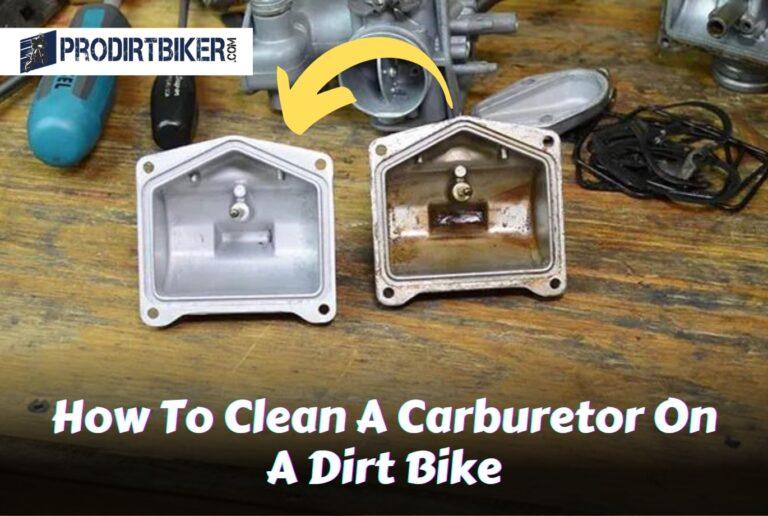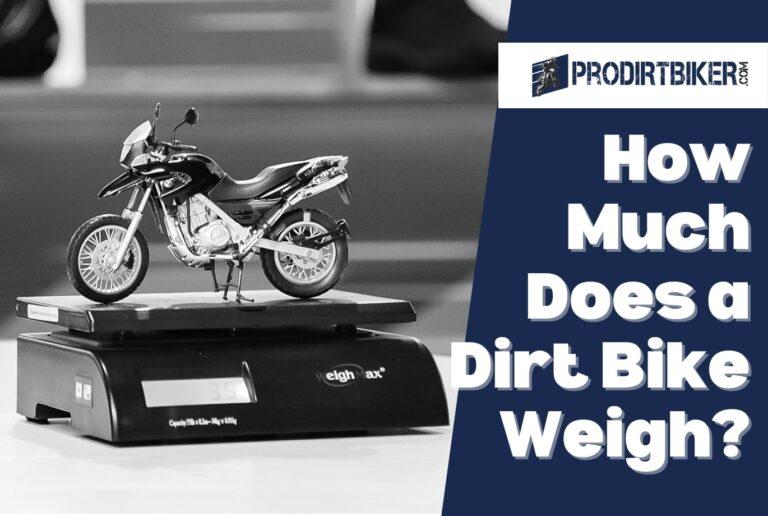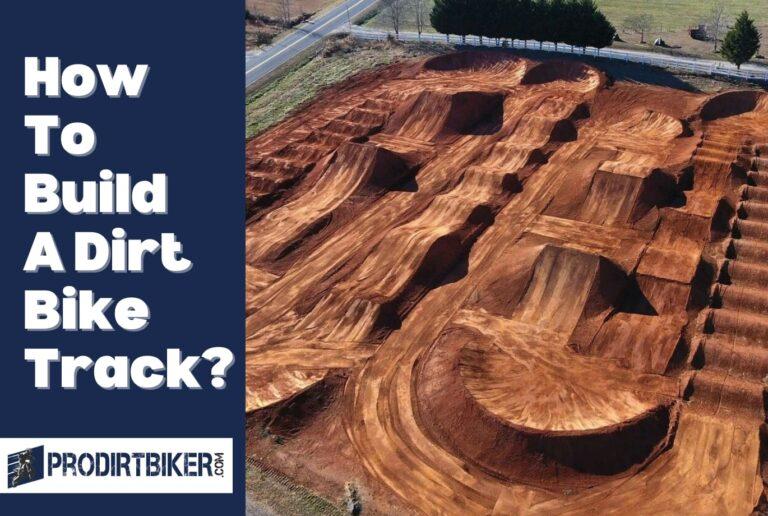How to Load a Dirt Bike Into a Truck? Expert Tips
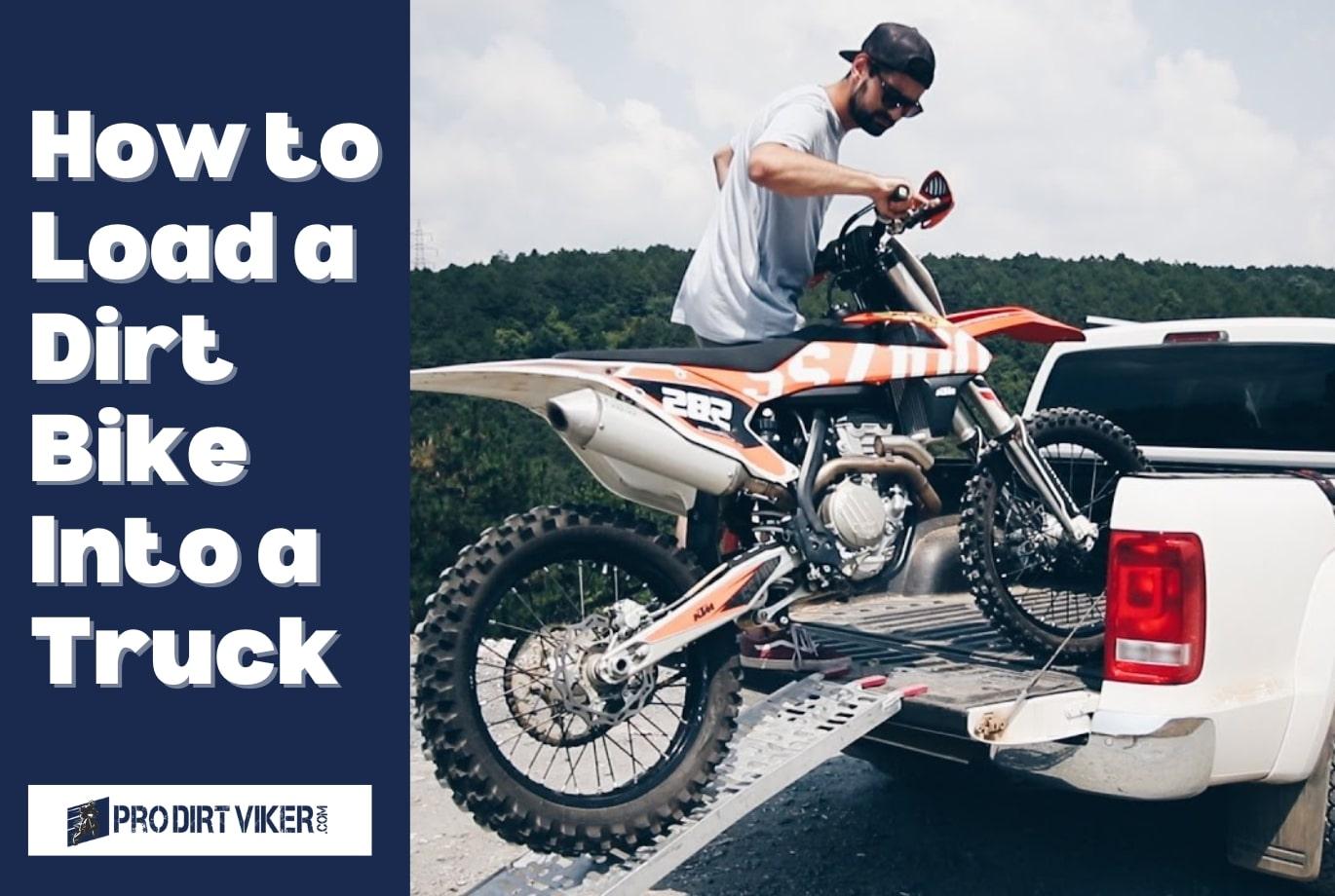
If you’re an avid dirt biker, you know that getting your bike to the trails or track is half the battle. Loading a dirt bike into a truck can be a daunting task, especially if you’re new to the sport or don’t have much experience with hauling equipment. But fear not!
In this blog post, we’ll walk you through step-by-step how to load a dirt bike into a truck safely and efficiently. Whether you’re heading out for a weekend adventure or just need to transport your bike to the shop, these tips and tricks will have you loading up in no time. So grab your helmet and let’s get started!
How to Load a Dirt Bike Into a Truck Step by Step Process?
To load a dirt bike into a truck, position a loading ramp securely against the truck bed and ensure it is sturdy enough to support the bike’s weight. Then, carefully push the dirt bike up the ramp, using your legs to provide support and control during the process.
Loading a dirt bike into a truck can be done safely and efficiently with the right equipment and technique. Here’s a step-by-step guide:
1. Gather the Necessary Equipment:
- A sturdy loading ramp
- Tie-down straps
- Protective gear (gloves, helmet, etc.)
2. Choose a Suitable Location:
- Find a flat and stable surface for loading the dirt bike.
3. Position the Truck:
- Back the truck up to a location where you can easily access it with the loading ramp.
4. Prepare the Dirt Bike:
- Ensure the dirt bike is in neutral gear.
- Remove any loose items from the bike.
- If possible, fold the mirrors or handlebars to make it easier to fit through the truck bed opening.
5. Set Up the Loading Ramp:
- Place the loading ramp securely on the truck bed and make sure it’s stable.
- Ensure the bottom of the ramp is on solid ground.
6. Walk the Dirt Bike Up the Ramp:
- With the help of a friend, push the dirt bike up the loading ramp.
- Use the throttle and brakes to control the speed.
7. Balance and Center the Bike:
- Position the dirt bike in the center of the truck bed to distribute weight evenly.
- Ensure the bike is stable and won’t tip during transport.
8. Secure the Dirt Bike:
- Use tie-down straps to secure the dirt bike to anchor points in the truck bed.
- Place the straps over the handlebars and through the frame or other sturdy parts.
- Tighten the straps evenly to prevent the bike from shifting.
9. Double-Check Everything:
- Ensure that the dirt bike is securely fastened and won’t move during transport.
- Confirm that the loading ramp is removed from the truck bed.
10. Drive Carefully:
- Accelerate and brake gently to avoid sudden movements that could destabilize the bike.
- Pay attention to the dirt bike in the rearview mirror to ensure it remains secure.
By following these steps, you can safely load a dirt bike into a truck for transport. Always prioritize safety, and if you’re unsure about any step, seek assistance from someone with experience.
Now, let’s delve into each step in detail to ensure a smooth loading process.
1. Gather Your Equipment
Before you begin, make sure you have all the necessary equipment: a loading ramp, tie-down straps, protective gear, and a friend to assist you. Safety should always be your top priority.
2. Choose the Right Truck
Ensure your truck is the right size and type to accommodate your dirt bike. A pickup truck with a long bed is ideal, but you can also use trailers or specialized bike carriers.
3. Prepare the Truck Bed
Clean the truck bed and remove any obstacles or debris. Make sure it’s level and stable to prevent accidents during loading.
4. Get Your Dirt Bike Ready
Before loading, ensure your dirt bike is in neutral gear and the engine is off. Remove any accessories that could get in the way.
5. Position the Ramp
Place the loading ramp securely against the truck bed, ensuring it’s at the correct angle for easy loading.
6. Secure the Ramp
Use straps or clamps to secure the ramp to the truck bed to prevent it from slipping during the loading process.
7. Push or Ride the Bike Up the Ramp
With a friend’s help, carefully push or ride the dirt bike up the ramp. Use the throttle and brakes as needed to maintain control.
8. Balance and Align the Bike
Position the dirt bike centrally on the truck bed to ensure weight distribution and stability. Align the front wheel with the wheel chock if available.
9. Secure the Dirt Bike
Use high-quality tie-down straps to secure the dirt bike firmly to the truck bed. Make sure the straps are tight and that the bike won’t shift during transit.
10. Double-Check Everything
Before hitting the road, double-check that the bike is securely fastened, and all equipment is properly stowed. Test the brakes and lights to ensure they’re functioning correctly.
11. Unload with Care
When you reach your destination, follow the same steps in reverse to unload the dirt bike safely.
12. Safety Tips
- Always wear protective gear, including a helmet, gloves, and appropriate clothing.
- Never load a bike when you’re fatigued or rushed.
- Maintain a slow and steady pace during loading and unloading.
- Regularly inspect your equipment for wear and tear.
13. Maintenance Considerations
Frequent loading and unloading can put stress on your dirt bike and equipment. Regularly inspect your bike’s suspension, tires, and other components for any signs of damage or wear.
14. Common Mistakes to Avoid
- Overlooking proper strap tension
- Using a makeshift ramp
- Neglecting to secure the ramp
- Ignoring safety gear
- Rushing the loading process
Ensuring Safety And Proper Equipment
Loading a dirt bike into a truck requires careful planning and the use of proper equipment to ensure safety for both the rider and the bike. With the right approach and some essential safety gear, you can efficiently load your dirt bike without any hassle.
Essential Safety Gear For Both The Rider And The Bike:
- Helmet: The rider should always wear a well-fitting helmet to protect their head in case of any accidents or falls.
- Gloves: Using gloves will provide a better grip on the bike’s handles and protect the rider’s hands from injuries.
- Boots: Sturdy boots with ankle support are crucial to protecting the rider’s feet and ankles from any impact or possible accidents.
- Goggles: Wearing goggles will shield the rider’s eyes from dust, dirt, and debris while riding.
Checking Tire Pressure And Bike Condition:
Before loading the dirt bike onto the truck, it is essential to check its tire pressure and overall condition. A well-maintained bike ensures a smooth and safe journey:
- Tire pressure: Make sure the bike’s tires are adequately inflated to ensure stability while loading and unloading.
- Brake check: Test the bike’s brakes to ensure they are functioning correctly, providing the rider with optimal control during the loading process.
- Suspension check: Check the suspension of the bike to ensure it can handle the weight during transportation.
- Oil and fuel levels: Confirm that the bike has sufficient oil and fuel for the journey, avoiding any last-minute surprises.
Using Proper Loading Equipment And Accessories:
To load your dirt bike into a truck safely, it’s essential to use suitable loading equipment and accessories:
- Loading ramp: Invest in a sturdy loading ramp designed explicitly for dirt bikes. This will ensure a gradual and secure ascent onto the truck bed.
- Tie-down straps: Use high-quality tie-down straps to secure the bike firmly to the truck bed, preventing any movement during transportation.
- Wheel chocks: Wheel chocks are essential to keep the front wheel of the dirt bike in place during loading, providing extra stability.
- Extra padding: Use soft padding or blankets to protect the truck bed and bike from scratches or any potential damage.
Following these safety precautions and utilizing the right equipment will help you load your dirt bike into a truck safely. Prioritizing safety, checking the bike’s condition, and having the proper loading equipment will make the process smoother and ensure a worry-free journey for both you and your dirt bike.
Adjusting The Truck Bed
Preparing to load a dirt bike into a truck requires careful attention to adjusting the truck bed. Without proper adjustment, you could run into issues like damage to the bike, instability during transportation, or even accidents. So, let’s dive into the key points of adjusting the truck bed to ensure a safe and efficient loading process:
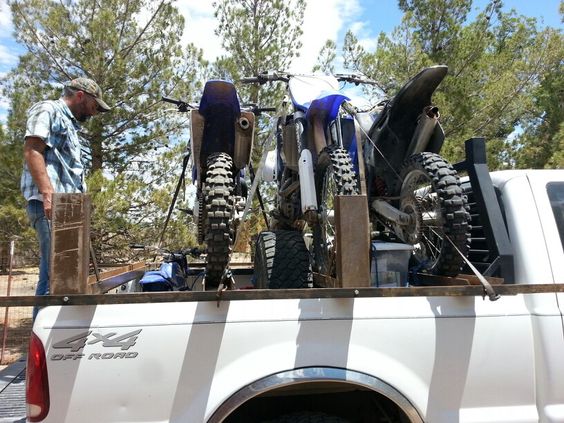
Clearing Any Obstacles From The Truck Bed
Before you can begin loading your dirt bike, it’s essential to clear any obstacles from the truck bed. These could include loose items, tools, or debris that may interfere with the bike or potentially cause harm. Here’s what you need to do:
- Remove any loose items from the bed, such as gear, tools, or debris, to create a clear and safe surface.
- Store these items securely elsewhere in the truck or in a separate compartment, ensuring they won’t shift or disrupt the loading process.
Understanding The Weight Capacity Of Your Truck
Understanding the weight capacity of your truck is crucial for a successful loading experience. Overloading the truck can lead to instability, poor handling, and even damage to the vehicle. Here’s what you need to keep in mind:
- Consult your truck’s owner manual or contact the manufacturer to determine the maximum weight capacity of your specific make and model.
- Consider the weight of the dirt bike and any additional accessories or gear you may be hauling. Ensure that the combined weight is within the truck’s capacity.
Positioning The Truck Bed For Optimal Loading
Positioning the truck bed properly is vital to ensure maximum stability and ease of loading. Follow these steps for optimal positioning:
- Park the truck on a level surface to provide a stable foundation for loading.
- Ensure that the truck is in park and the parking brake is engaged for added safety.
- If possible, position the truck parallel to a curb or wall to allow for easier access and stability during loading.
Now that you have a better understanding of how to adjust the truck bed, you’re ready to move on to the next step of loading your dirt bike. Stay tuned for the upcoming sections, which will guide you through securing the bike and ensuring a safe journey.
Proper Lifting Techniques
Riding a dirt bike can be an exhilarating experience, but when it comes to loading it into a truck, proper technique is essential. Not only will using the right lifting methods protect your body from injury, but it will also ensure the safety of your bike during transportation.
In this section, we will discuss the key points of proper lifting techniques for loading a dirt bike into a truck.
Maintaining A Sturdy Stance And Grip
- Stand with your feet shoulder-width apart, ensuring a stable base.
- Bend your knees slightly to maintain balance and stability.
- Keep your back straight and avoid slouching or hunching over.
- Position your hands on the handlebars or the designated lifting points on the bike.
- Maintain a firm grip to prevent the bike from slipping or falling.
Lifting With Your Legs, Not Your Back
- Engage your leg muscles to provide the necessary power for lifting.
- Bend at the knees while keeping your back straight.
- Use your leg muscles to lift the bike, avoiding strain on your back.
- Maintain a controlled, smooth lifting motion.
- Avoid twisting your body while lifting, as this can increase the risk of injury.
Distributing The Weight Evenly
- Before lifting, ensure that the bike is properly balanced on the truck ramp or loading platform.
- Lift the bike by its center of gravity to maintain stability.
- If the bike has excessive weight on one side, readjust the position to distribute the weight evenly.
- Take into consideration any additional gear or accessories that may affect the weight distribution.
- Double-check that the bike is securely positioned in the truck before securing it for transportation.
Remember, proper lifting techniques are crucial for loading a dirt bike into a truck safely and efficiently. By following these guidelines, you can protect yourself from unnecessary injuries and ensure that your bike remains secure during transportation.
Securing The Bike To The Truck
When it comes to loading a dirt bike into a truck, it is crucial to secure the bike properly to ensure a safe and hassle-free ride. Here are the key points to keep in mind when securing your bike to the truck:
Choosing the right tie-down straps:
- Opt for high-quality, durable tie-down straps specifically designed for securing motorcycles.
- Look for straps that have a sufficient weight capacity to safely secure your dirt bike.
Securing the bike using proper attachment points:
- Locate the designated tie-down points on your dirt bike. These are usually located on the front forks and rear frame.
- Attach the tie-down straps to these points, making sure they are tightly secured.
Checking the tightness of the straps and adjusting as necessary:
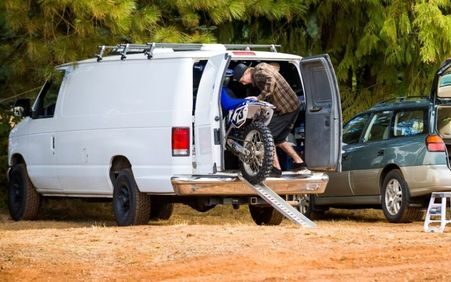
- Once the bike is in the truck bed, check the tightness of the straps to ensure a secure fit.
- Adjust the straps as necessary, making sure they are snug but not overly tightened.
- Double-check each strap to ensure it is properly secured before hitting the road.
Remember, securing your dirt bike properly is crucial for both your safety and the safety of others on the road. By following these steps and using the right equipment, you can have peace of mind knowing that your bike is securely fastened and ready for transportation.
Happy riding!
Utilizing Ramp And Assistance
Using A Sturdy Loading Ramp For Easy Access
Loading a dirt bike into a truck can be a challenging task if you don’t have the right equipment and techniques. One essential tool that can make the process smoother is a sturdy loading ramp. Here are some key points to consider when utilizing a loading ramp:
- Choose a loading ramp that is specifically designed for dirt bikes. These ramps are typically lightweight yet durable, providing the necessary strength to support the weight of your bike.
- Ensure that the ramp is long enough to provide a gradual incline. This will allow for a smoother transition when loading and unloading the bike.
- Make sure the ramp is securely attached to the truck bed to avoid any accidents or slips during the process.
- Inspect the ramp for any damage or defects before each use. A damaged ramp could compromise the safety and stability of the loading process.
- Position the ramp in a way that provides a clear and unobstructed path for your bike to climb onto the truck bed.
Enlisting The Help Of A Spotter Or Second Person
Loading a dirt bike into a truck becomes much easier when you have an extra set of hands to assist you. Here are some considerations when enlisting the help of a spotter or second person:
- Assign a spotter who is familiar with the loading process and understands their role in guiding and supporting you.
- Communicate with your spotter beforehand to establish clear signals and commands that you both understand. This will ensure a smooth and coordinated loading process.
- The spotter should stand at a vantage point where they have a clear view of both the loading ramp and the bike. They can provide guidance and offer assistance in case of any difficulties.
- The spotter should be ready to support and stabilize the bike as it climbs the ramp, preventing any tipping or unsteady movements.
- It is essential for the spotter and the person loading the bike to work together as a team, maintaining clear communication and coordination throughout the process.
Making The Loading Process Smoother And Safer
Loading a dirt bike into a truck requires careful planning and attention to safety. Here are some tips to ensure a smoother and safer loading process:
- Before attempting to load the bike, ensure that the truck bed is clean and free of any debris that could interfere with the loading process or damage the bike.
- Take your time and approach the loading process with caution. Rushing or neglecting safety measures can lead to accidents or damage to the bike.
- Secure the bike’s brakes to prevent any unintentional movement during the loading process.
- Make sure you have a clear path and enough space to maneuver the bike into the truck bed. Remove any obstacles or obstructions that could impede the process.
- Check the tie-down straps or any other securing devices to ensure they are in good condition and functioning properly. Properly securing the bike will prevent it from shifting during transportation.
By utilizing a sturdy loading ramp, enlisting the help of a spotter or second person, and following these safety guidelines, you can ensure a smooth and safe loading process for your dirt bike into a truck.
Practicing Loading Techniques
Loading a dirt bike into a truck can be tricky, especially if you’re new to the process. However, with repeated practice and the right techniques, you’ll become a pro in no time. Practicing loading and unloading procedures is essential to ensure a smooth and safe experience.
Here are some key points to keep in mind:
Repeatedly Practicing Loading And Unloading Procedures
- Familiarize yourself with the dimensions of your truck bed and the weight capacity it can handle.
- Before attempting to load the dirt bike, clear the area in and around the truck to ensure a safe working space.
- Start by positioning the truck in an open area with enough room to maneuver the bike onto the tailgate.
- Practice using a loading ramp, aligning it properly with the truck bed to create a smooth transition for the bike.
- Experiment with different loading angles and techniques to find the most comfortable and efficient method for you.
- Make sure to secure the loading ramp properly to prevent accidents during the process.
- As part of your practice, develop a routine for securing the bike once it’s in the truck, using straps or tie-downs to keep it stable.
- Practice unloading the dirt bike safely and smoothly to prevent any damage or injuries.
Tips For Maneuvering The Bike Up The Ramp
- Start by positioning the bike at the base of the ramp, ensuring it is in neutral and the engine is off.
- Keep your feet on the ground for stability and control as you slowly walk the bike up the ramp.
- Use your body weight to your advantage, leaning back slightly to counterbalance the weight of the bike.
- Maintain a steady pace and avoid sudden movements that could cause the bike to tip or become unstable.
- If you’re struggling to push the bike up the ramp, enlist the help of a friend to provide extra support and guidance.
Troubleshooting Common Loading Challenges
- If the bike feels too heavy to push up the ramp, consider using a winch or a loading assist device to ease the process.
- If the bike is too tall to fit under the truck’s roof, consider removing the handlebars or lowering the suspension temporarily.
- For bikes with a low ground clearance, be cautious of the ramp angle to prevent scraping or bottoming out.
- In case the bike becomes unbalanced or tilts while loading, stop immediately and reassess the situation before proceeding.
With practice and adherence to safety guidelines, loading a dirt bike into a truck can become second nature. Remember to always prioritize safety, take your time, and seek assistance if needed. So, get out there and become a loading pro!
Frequently Asked Questions On How To Load A Dirt Bike Into A Truck
How Do You Load A Dirt Bike Into A Truck Bed?
To load a dirt bike into a truck bed, position the ramp securely, use tie-down straps to secure the bike, then carefully push or ride it up the ramp.
What Type Of Ramp Is Best For Loading A Dirt Bike Into A Truck?
A sturdy and non-slip loading ramp made of aluminum or steel is best for loading a dirt bike into a truck safely and efficiently.
How Can I Secure The Dirt Bike For Transportation?
To secure the dirt bike for transportation, use high-quality tie-down straps, ensuring they are tight and properly fastened to prevent any movement during transit.
Are There Any Safety Precautions To Consider When Loading A Dirt Bike Into A Truck?
Yes, it is important to wear appropriate protective gear, have a spotter to assist, and check the ramp and tie-downs for secureness before loading the dirt bike.
Can I Load A Dirt Bike Into A Truck Bed By Myself?
Yes, it is possible to load a dirt bike into a truck bed by yourself, but having a second person to assist makes the process safer and easier.
Conclusion
Loading a dirt bike into a truck may seem like a challenging task, but with the right techniques and precautions, it can be done safely and efficiently. By following the steps outlined in this article, you can ensure that both your dirt bike and your truck remain in good condition during the loading process.
Remember to clean your bike before loading it to prevent debris from causing damage, and make use of sturdy ramps or loading systems to ensure a smooth transition. Take the time to secure your dirt bike properly using tie-down straps or a wheel chock, and double-check that everything is secure before hitting the road.
By taking these steps and practicing safe loading techniques, you can enjoy hassle-free transportation and many thrilling rides on your dirt bike. So, get ready to hit the trails and explore new terrains with confidence, knowing that your dirt bike is loaded securely in your truck.

